AESLA 2023: Silvia Murillo explores reformulation through emojis in Twitter

Dr. Silvia Murillo was a presenter at the 40th AESLA (Asociación Española de Lingüística Aplicada) conference, organised by the University of Extremadura from 26th to 28th April 2023. In her paper, she explored the reformulation processes performed by emoji in the Twitter accounts from international research projects (from the Horizon 2020 programme). For this, Murillo applied a taxonomy of reformulation processes based on the presence of emoji types, and considered the discourse processes and emoji-verbal text interaction patterns found in the tweets.
The full abstract of Silvia Murillo’s talk can be consulted as follows:
Reformulating through emoji in Twitter accounts of international research projects
International projects make their research visible through their websites, and many of them use an associated Twitter account in order to enhance communication with their potential diversified audiences. Thanks to the affordances of the platform, emoji are often introduced in the tweets, with different functions (Yus 2022). In a relatively frequent pattern, textual content is rendered into emoji, or the other way round, emoji are introduced first and then expressed in words. For some authors these uses of emoji are just colourful (Siever & Siever 2020) or redundant (Panckhurst & Frontini 2020) additions, not being required in order to understand the text. On the other hand, for Logi & Zappavigna (2021), these occurrences form part of ‘ideational emoji’ and interact with text to create meaning; and for Pascual & Mur (in press), they can be analysed as code glosses in a metadiscourse framework.
In this paper I relate the use of these ideational emoji to the processes of reformulation in Murillo’s taxonomy (2012), offering an alternative perspective to the study of how these items interact with written text.
My database is a subset of the EUROPROtweets corpus (Pascual et al. 2020) and comprises the tweets of 10 Twitter accounts associated to H2020 research websites, coded through NVivo. The variables analysed include the discourse processes in which the emoji appear (i.e. translation/explanation, identification, specification, conclusion), their scope (ranging from concepts to clauses) and position.
Essentially, these patterns display a mixture of reformulation processes and modal reinforcement, also present in some verbal reformulations; while the emoji do not contribute to clarifying the messages, they reinforce them and make them more engaging (c.f. Völkel et al. 2019). In short, these items enhance the interaction and dialogicity with the readers of Twitter messages for research purposes (cf. Pascual & Mur 2022).
Keywords:
Emoji, reformulation processes, Twitter for research purposes, international research projects, digital visibility
References:
Logi, L. & M. Zappavigna. 2021. A social semiotic perspective on emoji: How emoji and language interact to make meaning in digital messages. New Media & Society 0(0). https://doi.org/10.1177/14614448211032965
Murillo, S. 2012. The use of reformulation markers in Business Management research articles: An intercultural analysis. International Journal of Corpus Linguistics 17(1). 64-90. https://doi.org/10.1075/ijcl.17.1.03mur
Panckhurst, R. & F. Frontini. 2020. Beyond the Binary: Emoji as a Challenge to the Image-Word Distinction. In C. Thurlow, C. Dürscheid and F. Diémoz (eds.), Visualizing Digital Discourse: Interactional, Institutional and Ideological Perspectives. Berlin: De Gruyter Mouton. 81-103.
Pascual, D. & P. Mur-Dueñas, P. 2022. Dialogic interaction with diversified audiences in Twitter for Research Dissemination Purposes. CLAC 90. 61-79. https://doi.org/10.5209/clac.81307
Pascual, D., P. Mur-Dueñas & R. Lorés. 2020. Looking into international research groups’ digital discursive practices: Criteria and methodological steps in the compilation of the EUROPRO digital corpus. Research in Corpus Linguistics 8(2). 87-102. https://doi.org/10.32714/ricl.08.02.05
Siever, C. M. & T. Siever. 2020. Emoji-Text Relations on Instagram: Empirical Corpus Studies on Multimodal Uses of the Iconographetic Mode. In H. Stoeckl, H. Caple and J. Pflaeging (eds.), Shifts Towards Image-Centricity in Contemporary Multimodal Practices. Abingdon: Routledge. 177-203.
Völkel, S. T., D. Buschek, J. Pranjic & H. Hussmann. 2019. Understanding emoji interpretation through user personality and message context. In Proceedings of the 21st International Conference on HumanComputer Interaction with Mobile Devices and Services, MobileHCI ’19, New York, NY, USA. Association for Computing Machinery.
Yus, F. 2022. Smartphone Communication. Interactions in the App Ecosystem. London: Routledge.
